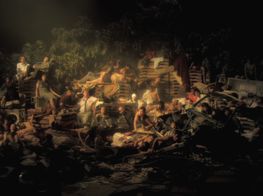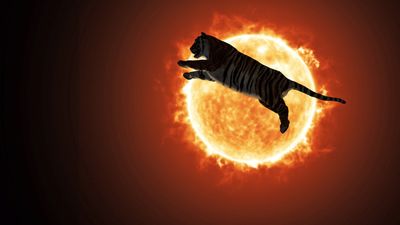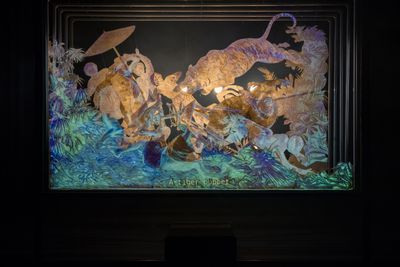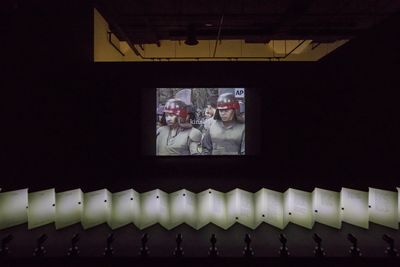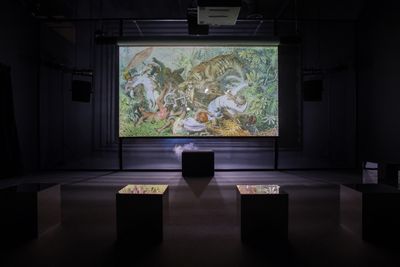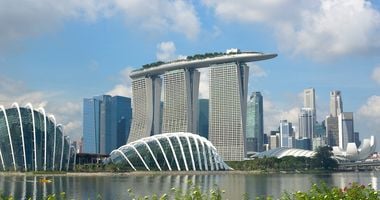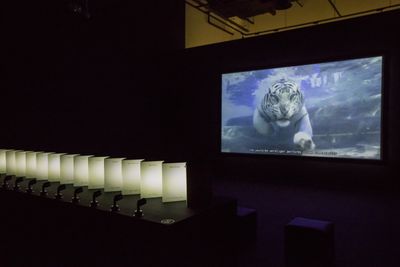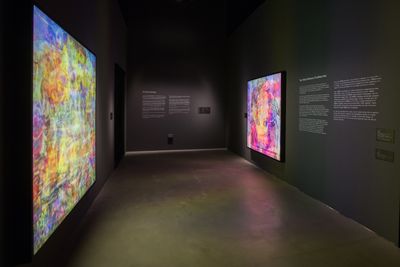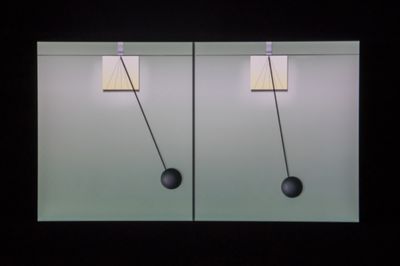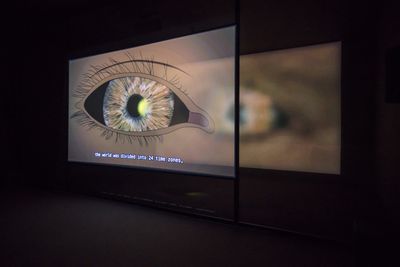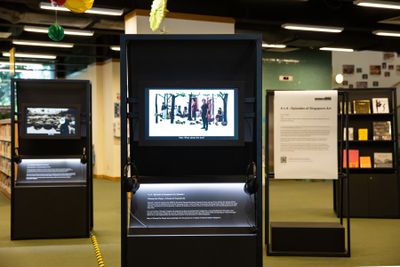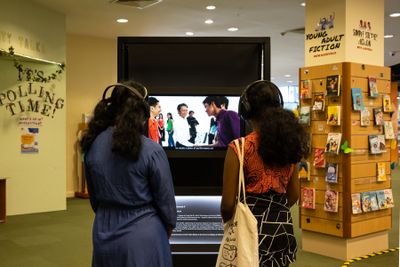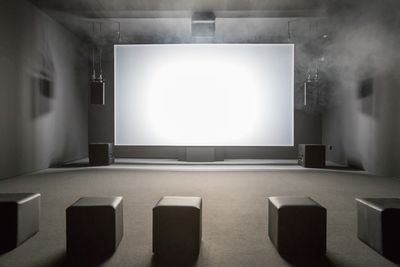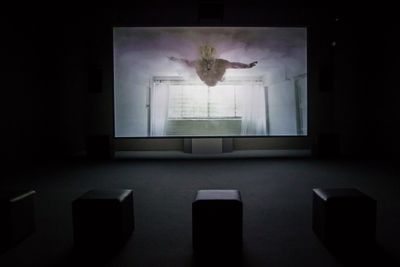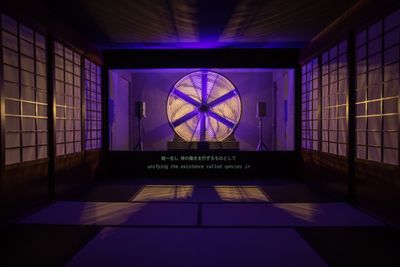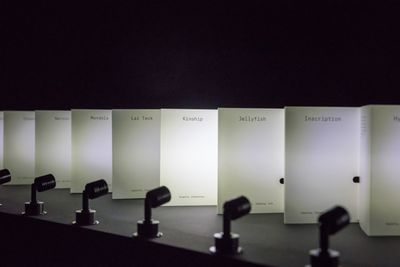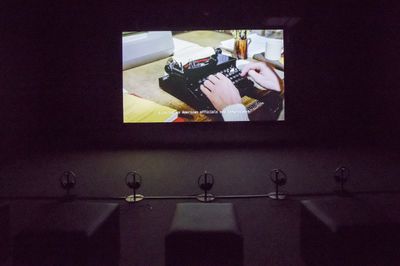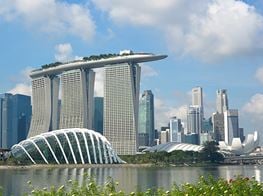Ho Tzu Nyen on Time and the Tiger
Ho Tzu Nyen. Courtesy Singapore Art Museum.
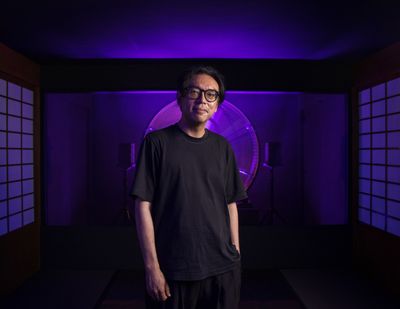
Ho Tzu Nyen. Courtesy Singapore Art Museum.
Ho Tzu Nyen is as much a thinker as he is an artist. Driven by a curiosity for philosophical ideas and aesthetics, Ho has extensively researched diverse fields including Southeast Asian histories, Japanese philosophy, and art-historical symbolism.
Watching his films and videos—unbound to circumscriptions of discipline, medium, or theme—is like seeing a diligent essayist's words come alive in real-time.
In his foundational video work, 'The Critical Dictionary of Southeast Asia (CDOSEA)' (2017–ongoing), Ho deploys both chance and order to synthesise research and aesthetics of the region. Each segment of the video contains algorithmically randomised video and audio clips from the artist's database. These are loosely correlated with Ho's propositions about Southeast Asia—for example, A for Altitude; Z for Zone—that are sung by a lilting narrator. Collaborating with animators, musicians, and actors, Ho artistically purveys historical and regional research material. To describe Ho's works using catch-all terms like 'Southeast Asian identity' would therefore be a disservice to his epistemological pursuits, a reductive ring-fencing of his cerebral apparatus.
Ho's first mid-career retrospective, Time & the Tiger (24 November 2023–3 March 2024), gathers nearly two decades of films, performances, and video installations at Singapore Art Museum. Displayed across two galleries are eight video installations, among them Hotel Aporia (2019), a six-channel video work screened in rooms modelled after traditional Japanese inns or ryokan that modifies scenes from Yasujirō Ozu's films from the 1940s to 1960s to interrogate conflicting ideologies of war.
Also presented is The Cloud of Unknowing (2011), a rumination on the motif of the cloud that Ho made for the Singapore Pavilion at the 54th Venice Biennale; the 2015 video The Nameless, a personification of a triple-agent known only as Lai Teck through found footage of Hong Kong actor Tony Leung; and One or Several Tigers (2017), in which Ho tracks the elusive Malayan tiger through Singapore's history.
Throughout the show, Ho's destabilisation of inherited historical, theoretical, and political dogmas—for example, the geography of Southeast Asia, or the linear flow of time—is difficult to ignore. In this conversation, Ho shares more about the concepts of time and tigers—linchpins in his process, from which the exhibition derives its title, along with the language of abstraction and the contingencies of intellectual freedom.
WBHLet's begin with the exhibition's title: Time & the Tiger. Although both aspects have been central to your practice and often overlap, you have not explicitly coupled them before. Why did you make this association between time and the tiger more apparent in this exhibition?
HTNI have a predilection for alliteration as part of a chance operation to fold together things, which seem to be far apart—like time and tigers. In this specific instance, this act of folding connected me to a lineage, since time and tigers have been previously brought together by two very different writers: Jorge Luis Borges and Georges Bataille.1 Both have been important inspirations for me at different moments of my practice—Borges with his paradoxes, and Bataille with his excesses.
Tigers have appeared in different works that I made, beginning with my first video, Utama - Every Name in History is I (2003), which was about the pre-colonial, mythical founder of Singapore, Sang Nila Utama.
Utama is described as a prince from Palembang, Indonesia, who supposedly spotted a lion when he arrived on the island and thus named it Singapura, which is Sanskrit for Lion City. Of course, lions cannot be found in Southeast Asia. But we did have lots of tigers—perhaps he spotted a tiger. This is how the tiger, for me, became a spectral, unnamed presence at the heart of our origins.
The origin, as Derrida tells us, returns because it was, in the first place, not all there, without fault, and complete. In preparing for this exhibition—for which I had to gather works from two decades of my practice, I could see the tiger's incessant return. The tiger traverses space and leaps through time. It is, for me, the sign of the eternal return.
WBH'The Critical Dictionary of Southeast Asia (CDOSEA)' is arguably at the core of your practice. Your starting point for this video work was the question: 'Does Southeast Asia have a coherent, unified regional identity, given its many political, ethnic, linguistic, and religious diversities?' Have you found an answer to this? Do you think this is a relevant or rhetorical query today?
HTNI am much more drawn to questions than answers. Good questions open things up, while the typical answer narrows things down. In a way, questions already contain their possible answers, but the best questions are unanswerable, and thus inexhaustible. Unanswered questions, like the tiger, retain the possibility of returning again and again in time. They don't get used up by a single, definite answer. The single, authoritative, and often authoritarian narrative is the province of priests and judges, and the enemy of my work.
I wanted to find out how [stories] resonate with life as I live it—its little joys, small acts of heroism and absurdity, with memory and death.
The algorithmic editing system of 'CDOSEA' was designed to generate a multiplicity of possible answers, which function as propositions of how Southeast Asia can be imagined. Each proposition is just a render. To adapt a quip from Jean-Luc Godard: 'Not a just render, just a render.'2
The content of the question, 'What is Southeast Asia?', may be relevant to some of us from this region. But I like to think that the form of the question can be adapted to many other situations. This query seems more relevant than ever in our present landscape which is marked by essentialist, exclusive, and highly destructive identity politics.
WBHRegarding essentialism, you said in an interview with Vdrome: 'To track the tiger is to embark on a journey that has no respect for national boundaries.' Why did you engage with the region (of Southeast Asia), as opposed to the modern form of the nation-state in this artwork and throughout your practice?
HTNTo me, dealing with the nation-state and the larger unit of the region of Southeast Asia is shifting between scales—a kind of zooming in or out, if you like. What interests me is how these imagined entities relate and resonate across the different scales in which they exist.
The single, authoritative, and often authoritarian narrative is the province of priests and judges, and the enemy of my work.
Some of my earlier works, particularly Utama - Every Name in History is I, dealt with the unit of the nation-state. Interestingly, tracking the genealogy of Singapore's pre-colonial founder constantly leads one to the region and beyond. He was said to be a prince from Sumatra, whose lineage extends to South Indian kings of the Chola empire, then to Alexander the Great, and even King Solomon.
The essence, the root, or the origin keeps leading us to the outside. And this makes me of think of a doughnut whose empty centre opens to the outside.
WBHWhat do you think your new commission for this exhibition, T for Time, contributes to your larger umbrella project, the 'CDOSEA'? Why was it important for you to add this artwork to the project at this specific moment in your practice?
HTNI regard 'CDOSEA' as a machine that produces propositions, while I think of T for Time as a machine that generates stories. Of late, I've felt the need to consider how the concepts, speculations and propositions that have always interested me relate to the here and now, of daily life, as I experience it.
Maybe this is why T for Time includes anecdotes one might call personal. This includes a true story about Mr P.K. Chan, the 79-year-old gentleman who manages the building where my studio is located, and who also happens to be the caretaker of what is possibly Singapore's most famous public clock at Victoria Theatre and Concert Hall for over 30 years, for which he is not able to leave for holidays for longer than five days.
I have also included family photographs and movies of my friend and frequent collaborator Tomoyuki Arai, which moved me so much. For me, T for Time is an attempt to consider the relationship to time in these anecdotes at the same level as the abstract and often mind-blowing concepts of time in physics, such as relativity, or the second law of thermodynamics. Time is the leveller.
I wanted to relate these lived, personal stories to time on the biological, sociological, geopolitical, and cosmic scales. I wanted to find out how they resonate with life as I live it—its little joys, small acts of heroism and absurdity, with memory and death.
WBHYou work predominantly with video. Why video? What do you think makes it a productive and suitable artistic medium within the Southeast Asian context?
HTNMy preference for video can probably be explained by my inability to say what video really is. My first encounter with video stems from adolescence when my family first bought a VHS player and subscribed to a network that rented out VHS tapes of suspicious quality and dubious origins. When I began making films, I could only afford to use video, even if my greatest cinematic inspirations like Andrei Tarkovsky, Robert Bresson, King Hu, and Godard were creatures of celluloid. Although, Godard would later become a profound user of video.
. . . unlike the largely formal games of much abstract and conceptual art, my parameters are born out of the geopolitical convolutions of our times.
In the early days of my practice, I remember an initial feeling of inadequacy—that because I was relegated to this impure medium of video, I was doomed to only pretend to be a filmmaker. But this sense of lack was thankfully short-lived, as I soon discovered, and completely surrendered to the surreptitious pleasures of videos.
In its fluidity and promiscuity, it is the medium par excellence for those who are challenged in terms of resources, such as money and space. Video is not exactly completely dematerialised, but it can be compressed, easily duplicated, and cheaply circulated. Best of all, when 'decompressed', it can fill a room with sound and image.
WBHLet's shift gears slightly from video to its not-so-distant cousin: television. Why did you choose to work with television in '4X4 – Episodes of Singapore Art' (2005), a series that aired on Singaporean television consisting of four episodes, each dedicated to a single, seminal artwork in Singapore's art history? What were the similarities and/or differences of working with television versus video?
HTN'4X4' was made in the medium of video. I understand television as a network of distribution. When '4X4' was made, the airwaves were monopolised by the state.
One starting point for '4X4' was the idea of infiltrating this system and use its outreach to extend my work beyond the gallery. But infiltrating the television network required that one take on the form of what counts as television—from hiring well-known actors to imbue a sense of familiarity to adopting certain formal habits such as having these actors, or presenters address audiences directly.
I attempted to take on these expectations seriously, and to me, this also usually means to find a way to subvert them. Of course, this experience differed from the process of making a video to be shown in a gallery, but to me, both are just different channels of production and dissemination. Each has its set of rules and habits—both written and unwritten, conscious and unconscious.
WBHYou often invoke the tenets of abstraction by speaking about repetition and difference, and self-imposed limitations in your artworks as generative parameters. For example, in relation to the alphabetically organised CDOSEA, you once said that 'The algorithmic editing system enabled me to present the collection (of digitally sourced video clips) as a whole, the infinite combinations generating unexpected linkages amongst the fragments, while producing an endless series of possible Southeast Asias.'
'4X4' is a not-so-subtle reference to the rigid confines and multiplicative possibilities of a square; while a blank white screen is the first frame in The Cloud of Unknowing (2011). And, on The 49th Hexagram (2020), your video and sound installation that reflects on uprisings in Korean history, you described transforming the restrictions and sensitivities of working with North Korean animators into productive pathways that influenced the aesthetic decisions in the work, such as the intentional omission of specific locations, environments, and facial features.
Why place these prohibitions on your process, and what effects do they have on your artworks?
HTNThe history of abstraction has always been a source of inspiration and questioning for me. Back in the early 2000s, I did not have the means to travel to see these works, but the writings of certain materialist and formalist art critics and historians were a formative influence. But at that time in Singapore, there didn't seem to be many who were interested in these ideas.
Naturally, I wondered if we were lacking something here. But soon enough, this thought flipped to the other side. Why were these discourses that have grown out of white Euro-American discourses necessary to Singapore? Around this time, I stopped making abstract paintings and began working on Utama - Every Name in History is I, which dealt with historical subjects in a narrative format.
Nevertheless, and as you have noted, some of these ideas from abstraction and conceptualism have become an irreducible part of my formal language, such as the presence of the blank screen in a number of my works. But I believe that my usage of this language is tied to my questioning as a non-white person operating from the so-called margins of these (former?) art centres. When I look at the blank screen in my work, I see not only the monochrome of abstraction, but also simultaneously the emptiness of Taoism. And I wonder if the two can ever meet, and if they do, on what grounds?
I sometimes borrow Sol LeWitt's idea that it is more interesting to make the machine that makes the art, rather than the art, to explain my interest in the algorithmic editing system of 'CDOSEA'. But unlike LeWitt, my output can only be narratives, dense and heavy with the nightmares of postcolonial histories.
I remain unable to enjoy the luxury of just making objects. In this way, we can also talk about The 49th Hexagram. This work was indeed formed by my attempt to convert prohibitions into formal parameters that can determine the final aesthetic form of the output. But unlike the largely formal games of much abstract and conceptual art, my parameters are born out of the geopolitical convolutions of our times.
WBHFrom listening to your lectures and talks, it is evident that you are an ardent researcher. What does artmaking provide you that research can't?
HTNReading and thinking about things remain the chief activities of my practice and everyday life. I don't think my research interests would have been an easy fit in an academic system, because of my perhaps undisciplined curiosity. For example, I spent most of the last two years trying to understand what the branches of contemporary physics have to say about time while reading about the horological histories of different cultures, the usage of time in literature and philosophy, and the temporal dimensions of animation.
For me, the best thing about being an artist is that it allows me to create my own rules of operating, thinking, and making. And I can present these understandings, intuitions, sensations, and questions in ways that are impossible in the linear medium of language.
WBHTo paraphrase one of your commentaries on your artwork: 'It's better to let 1001 stories [histories and identities] bloom, rather than to reduce everything to one story.' How do you think this consciousness can be attained?
HTNThere must be, at the very least, 1001 ways to attain this consciousness. Sadly, I only know of one—my own. I have a love of the multiple and an inherent distrust of all attempts to reduce the plurality of the world to 'the one', which is to say, all forms of essentialisms, and authoritarianism in all its disguises.
But this way of thinking also requires an acceptance of contradictions, which in turn, necessitates that I take seriously claims that oppose my beliefs. I think that this mode of consciousness requires an awareness, and modesty, about the contingent nature of one's perspectives and claims, and a certain willingness to subvert oneself, to learn and to continue to open up to the manifold thickness of this world. —[O]

